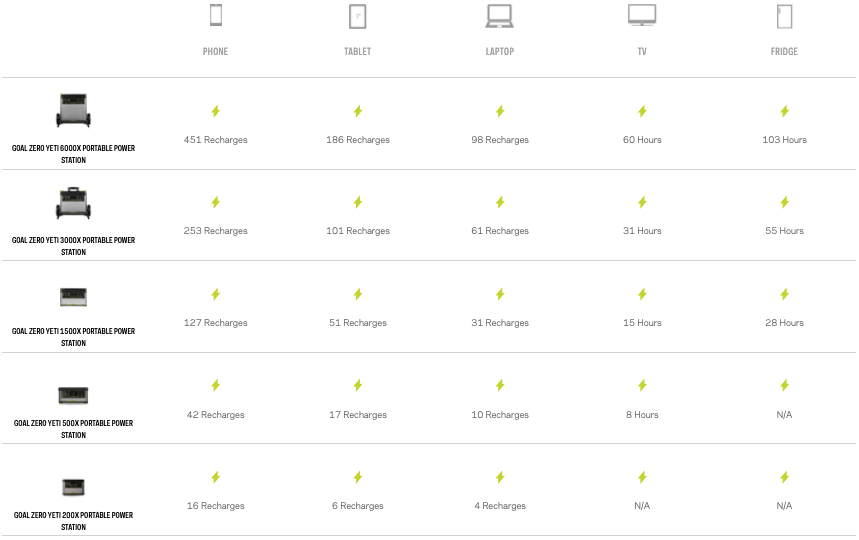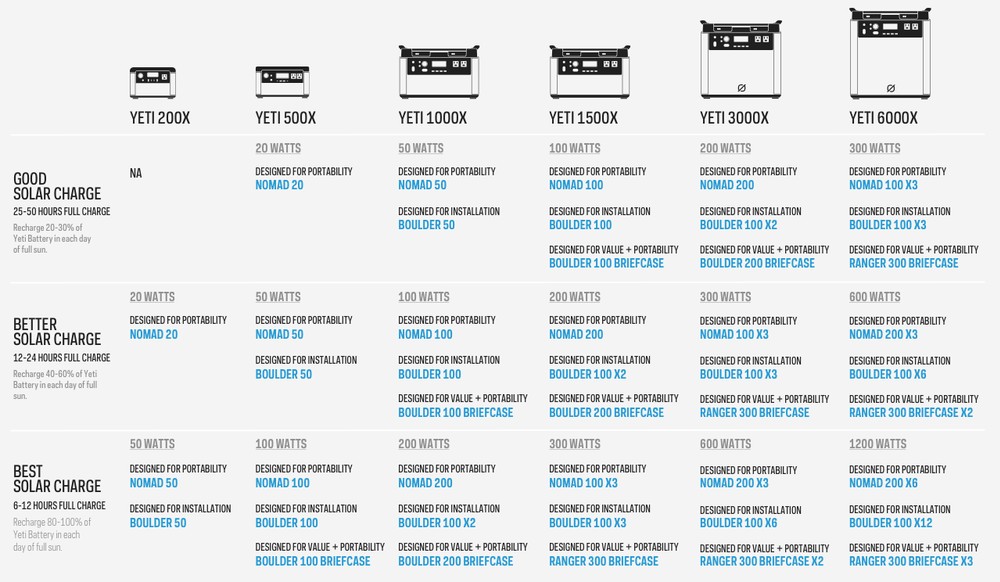Explained
Energy on the go
Just because you’re off the grid doesn’t mean you have to disconnect. Whether you’re living on the road or camping for the weekend, there are plenty of devices and appliances you might want to power. A portable power station can run everything from laptops and camera gear to blenders, heated blankets and more.
Why would you need a portable power station?
Are you looking for versatile, reliable power for your overland adventures? Something that can run fridges, communications, music or even grills, lighting and more? With a variety of ports and powering options it will allow you to charge up and run multiple devices all at the same time. Keep everything from camera gear and camping essentials to laptops and important medical devices charged and ready no matter where you go.
Even better? Stay in control with the app on your smartphone. Check your battery level, power in and out and even turn ports on and off, all from the palm of your hand.
Good to know, all the batteries we offer can be charged by either your wall outlet, car socket or by solar panels.
Benefits of a portable power station
- Charge all your electronics with one device: The best portable power stations can charge all of your electronics as well as multiple devices simultaneously. You won’t have to worry again about losing power while camping, hiking, fishing, and more.
- Convenient size that’s easy to travel with: Most portable power stations are compact and lightweight. They can easily be packed away in your vehicle, RV, or trailer to bring with you on long trips.
- Fully rechargeable: Portable power stations are completely rechargeable via any outlet, car adapter, or cigarette socket lighter. Just make sure you can charge at your campsite or that you have a sufficient charge before heading out on an overnight trip.
Before you buy
There are a few important factors that you have to think about before you decide what power station you need to buy:
- What do you intend to power? Your smartphone, laptop, a refrigerator or even a television?
- How much power do you need? Most manufacturers measure this in mAh (milliamp hours).
- What type of camper are you? Are you backpacking or car camping, backpacking requires a small lightweight portable power device while you have less restrictions when you go car camping.
- How often do you camp? If you camp on a regular basis, it’s probably worth investing in a more powerful device, even if it costs more.
- Where do you go camping? Solar power for camping is hot right now, yet it’s not right for every location and for some locations you’re better off with battery power. Keep in mind you can also charge your battery with solar power when you’re in the right spot.
Others things to keep in mind are:
- How many people will be used the power station?
- How many charges does the device provide?
- How big and heavy is the portable battery?
- Durability, ensure your power source is prepared for hot sun, snow and rain as well as bumps and bruises
- Features, how many charging ports does the device have? What outlets does it have?
- Does it need to be able to jumpstart a car?
How do you charge your battery?
Standard
Most portable power stations can be charged via any standard wall outlet. Once fully charged, it will provide enough power to operate most of your electronics and personal devices within your RV, trailer, or at your campsite. Some can even be charged via a car adapter or through your vehicle’s cigarette lighter socket.
Solar-powered
Portable power stations are available with an eco-friendly, solar-powered option. Solar panels can generate enough power to charge your power station’s lithium battery. Many solar-powered models also come with a standard cord to charge your station the traditional way if needed. If you opt for a solar-powered option, make sure to purchase a solar panel to connect to your power station. Most are sold separately.
How much power output do I need from my portable power device?

Choosing a solar panel to charge your battery with

*Charge times depicted in the “Yeti + Solar Charge Times” table assumes standard conditions of 75 degrees and 1000 watts/meter squared solar radiance. The lower end of the range requires frequent repositioning towards the sun, which results in the fastest charge times. The high end of the range presumes the panel is in a fixed position, which results in longer charge times.
Durability
No matter what your usage might be, the care and maintenance for your portable power station remains the same. We’ve pulled together a few tips and tricks to help you get the most out of your off grid experience, and keep your portable power station running through whatever comes your way.
Keep it charged
Try to keep your power station topped off at all times. This is an easy trick to always ensure your battery is ready for anything; however, it’s also the number one thing most owners forget to do on a regular basis. In addition, we recommend using your power station periodically to keep its battery in best working condition, even if you don’t necessarily need a constant source of big power.
Cold weather usage
If you’re planning on using your battery in cold (sub-freezing) conditions, there’s a possibility you’ll run into some issues. When a power station is too cold (0° C), they will stop accepting a charge, and if they’re even colder (-20° C), they’ll stop outputting power. A simple solution – keep your portable battery in a cooler. That extra layer of insulation and the natural heat created by the power station during use or while charging will help keep your battery working well in those frigid temperatures.
Hot weather usage
Just like the power stations don’t particularly enjoy extreme cold, they don’t operate at peak performance when placed in extreme heat either. They can stop accepting a charge at around 45° C and stop outputting power at around 65° C. Keeping proper ventilation around your battery at all times will help mitigate any potential mishaps while working in extremely hot conditions. In order to better protect them, they also have special features, such as automatic cooling systems. If you have a power station in the back of your car on a hot summer day and you hear a noise, it’s probably the fan kicking on to keep it cooled off.
The best power station
Our top pick
Run your essential devices and appliances with the Yeti 1000X. Our most versatile sized power station is big enough to power medium to large appliances and portable enough to pack in the car and go with you anywhere. Upgraded to include USB-C Power Delivery, integrated MPPT for increased solar charging efficiency, and faster recharge times. Power phones, laptops, camera equipment, portable fridges, medical devices, TV’s, and more.
The best solar panels to charge your Yeti 1000 X with?
Rugged, durable, and rigid. The Boulder 100 Briefcase Solar Panel is built with strong tempered glass and an aluminum frame with added corner protection for temporary or permanent installation.
Our most portable large solar offering, Nomads fold down to a quarter of their full size, making them ideal for situations where power needs are large and space is limited. The Nomad 200 provides up to 200 watts of solar to keep a Yeti power station charged and everything from laptops to fridges to medical devices running for days on end.
Best mid-sized power station
The EcoFlow Delta 1300 sets a new standard for cordless power generators. It has a capacity of 1260Wh, which makes it the most advanced model of the EcoFlow brand. Delta 1300 can be quickly charged using photovoltaic panels or by connecting it to a power outlet, and at the same time it is extremely versatile – it will power all the necessary devices – from phones and laptops, to household appliances, drones, tools, and even electric vehicles and medical devices.
Final thoughts
There is no one size fits all solution when it comes to portable power for camping. It all depends on what you’ll be charging, where you’ll go and what your musts and restrictions are.

